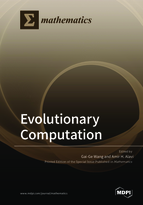Evolutionary Computation
A special issue of Mathematics (ISSN 2227-7390).
Deadline for manuscript submissions: closed (31 March 2019) | Viewed by 97917
Special Issue Editors
Interests: evolutionary computation; swarm intelligence; metaheuristics; fuzzy scheduling; big data optimization; multi-objective and many-objective optimization
Special Issues, Collections and Topics in MDPI journals
Interests: structural health monitoring; smart civil infrastructure systems; deployment of advanced sensors; energy harvesting; civil engineering system informatics
Special Issues, Collections and Topics in MDPI journals
Special Issue Information
Dear Colleagues,
Evolutionary computation (EC) is a family of algorithms for global optimization inspired by biological evolution. It includes various population-based trial and error problem solvers with a metaheuristic or stochastic optimization character. In EC, each individual has a simple structure and function. EC system is composed of many of these individuals and can address difficult real-world problems, which are impossible to be solved by single individuals. During the recent decades, the EC methods have been successfully applied to solve complex and time-consuming problems. The EC is indeed a topic of interest amongst researchers in various fields of science and engineering. Some of the most popular EC paradigms are genetic algorithm, genetic programming, and evolution strategy. Many theoretical and experimental studies have proved the significant properties of EC such as reasoning with vague and/or ambiguous data, adaptation to dynamic and uncertain environments, and learning from noisy and/or incomplete information.
The aim of this special issue is to compile the latest theory and applications in the field of EC. Submissions should be original and unpublished, and present novel in-depth fundamental research contributions either from a methodological perspective or from an application point of view. In general, we are soliciting contributions on (but not only limited to) the following topics:- Improvements of traditional EC methods (e.g., genetic algorithm, differential evolution, ant colony optimization and particle swarm optimization)
- Recent development of EC methods (e.g., biogeography-based optimization, krill herd (KH) algorithm, monarch butterfly optimization (MBO), earthworm optimization algorithm (EWA), elephant herding optimization (EHO), moth search (MS) algorithm, rhino herd (RH) algorithm)
- Theoretical study on EC algorithms using various techniques (e.g., Markov chain, dynamic system, complex system/networks, and Martingale)
- Application of EC methods (e.g., scheduling, data mining, machine learning, reliability, planning, task assignment problem, IIR filter design, traveling salesman problem, optimization under dynamic and uncertain environments)
Dr. Gai-Ge Wang
Dr. Amir H. Alavi
Guest Editors
Manuscript Submission Information
Manuscripts should be submitted online at www.mdpi.com by registering and logging in to this website. Once you are registered, click here to go to the submission form. Manuscripts can be submitted until the deadline. All submissions that pass pre-check are peer-reviewed. Accepted papers will be published continuously in the journal (as soon as accepted) and will be listed together on the special issue website. Research articles, review articles as well as short communications are invited. For planned papers, a title and short abstract (about 100 words) can be sent to the Editorial Office for announcement on this website.
Submitted manuscripts should not have been published previously, nor be under consideration for publication elsewhere (except conference proceedings papers). All manuscripts are thoroughly refereed through a single-blind peer-review process. A guide for authors and other relevant information for submission of manuscripts is available on the Instructions for Authors page. Mathematics is an international peer-reviewed open access semimonthly journal published by MDPI.
Please visit the Instructions for Authors page before submitting a manuscript. The Article Processing Charge (APC) for publication in this open access journal is 2600 CHF (Swiss Francs). Submitted papers should be well formatted and use good English. Authors may use MDPI's English editing service prior to publication or during author revisions.







